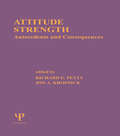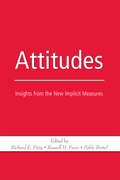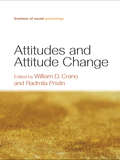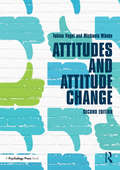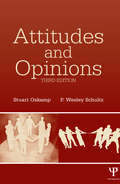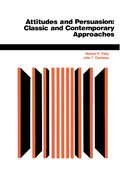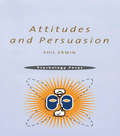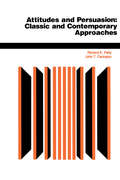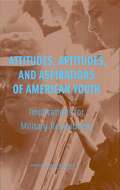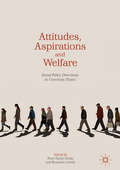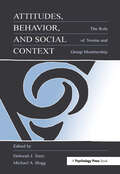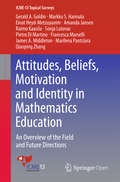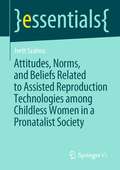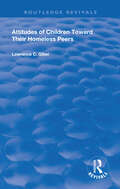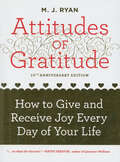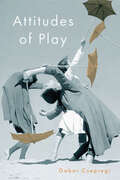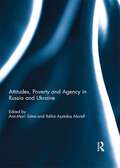- Table View
- List View
Attitude Reports (Key Topics in Semantics and Pragmatics)
by Thomas GranoPropositional attitude reports are sentences built around clause-embedding psychological verbs, like Kim believes that it's raining or Kim wants it to rain. These interact in many intricate ways with a wide variety of semantically relevant grammatical phenomena, and represent one of the most important topics at the interface of linguistics and philosophy, as their study provides insight into foundational questions about meaning. This book provides a bird's-eye overview of the grammar of propositional attitude reports, synthesizing the key facts, theories, and open problems in their analysis. Couched in the theoretical framework of generative grammar and compositional truth-conditional semantics, it places emphasis on points of intersection between propositional attitude reports and other important topics in semantic and syntactic theory. With discussion points, suggestions for further reading and a useful guide to symbols and conventions, it will be welcomed by students and researchers wishing to explore this fertile area of study.
Attitude Strength: Antecedents and Consequences (Ohio State University Volume On Attitudes And Persuasion Ser. #Vol. 4)
by Richard E. Petty Jon A. KrosnickSocial psychologists have long recognized the possibility that attitudes might differ from one another in terms of their strength, but only recently had the profound implications of this view been explored. Yet because investigators in the area were pursuing interesting but independent programs of research exploring different aspects of strength, there was little articulation of assumptions underlying the work, and little effort to establish a common research agenda. The goals of this book are to highlight these assumptions, to review the discoveries this work has produced, and to suggest directions for future work in the area. The chapter authors include individuals who have made significant contributions to the published literature and represent a diversity of perspectives on the topic. In addition to providing an overview of the broad area of attitude strength, particular chapters deal in depth with specific features of attitudes related to strength and integrate the diverse bodies of relevant theory and empirical evidence. The book will be of interest to graduate students initiating work on attitudes as well as to longstanding scholars in the field. Because of the many potential directions for application of work on attitude strength to amelioration of social problems, the book will be valuable to scholars in various applied disciplines such as political science, marketing, sociology, public opinion, and others studying attitudinal phenomena.
Attitude Structure and Function
by Anthony R. Pratkanis Steven J. Breckler Anthony G. GreenwaldUtilizing "new wave" research including new psychological theories, new statistical techniques, and a stronger methodology, this collection unites a diversity of recent research perspectives on attitudes and the psychological functions of an attitude. The objective of the editors was to bring together the bits and pieces of validated data into one systematic and adequate set of general principles leading to the view of attitudes as predictions. As the volume reformulates old concepts, explores new angles, and seeks a relationship among various sub-areas, it also shows improvements in the sophistication of research designs and methodologies, the specifications of variables, and the precision in defining concepts.
Attitudes: Insights from the New Implicit Measures (Key Readings In Social Psychology Ser.)
by Richard E. Petty Russell H. Fazio Pablo Bri X00F1 OlThis book tackles a subject that has captured the imagination of many researchers in the field: attitudes. Although the field has always recognized that people‘s attitudes could be assessed in different ways, from direct self-reports to disguised observations of behavior, the past decade has shown several new approaches to attitude measurement. Des
Attitudes and Attitude Change (Frontiers of Social Psychology)
by William D. CranoThis volume assembles a distinguished group of international scholars whose chapters on classic and emerging issues in research on attitudes provide an excellent introduction for advanced undergraduates and graduate students. The book’s chapters cover all of the most critical features of attitude measurement, attitude development, and attitude change. Implicit and explicit approaches to measurement and conceptualization are featured throughout, making this one of the most up-to-date treatments of attitude theory and research currently available. The comprehensive coverage of the central topics in this important field provides a useful text in advanced courses on persuasion or attitude change.
Attitudes and Attitude Change (Social Psychology A Modular Ser.)
by Tobias Vogel Michaela WankeAttitudes have been a central topic in social psychology from its early beginnings. But what exactly are attitudes, where do they come from, and how can they be modified? The overall aim of Attitudes and Attitude Change is to provide students with a comprehensive and accessible introduction to these basic issues in the psychological study of attitudes. In four parts, readers learn about how attitudes can be measured, how attitudes are shaped in the course of life, how they are changed by other people, and finally, how attitudes in turn affect our thoughts and behavior. This completely revised and updated second edition covers many recent developments and reports cutting-edge research while also addressing the classic findings and theories that advanced the field. In addition to integrating the newly emerged topics of implicit attitudes and recent models regarding the coexistence of explicit and implicit attitudes, this edition also adds chapters on social influence and resistance to persuasion. This comprehensive and user-friendly book carefully balances theoretical underpinnings and empirical findings with applied examples to enable readers to use the insights of attitude research for practical applications. Critical discussions also instigate readers to develop their own thinking on key topics.
Attitudes and Decisions (Psychology Revivals)
by J Richard Eiser Joop van der PligtThe concept of attitude has long been a central part of social psychological theories. It is important in other disciplines too, such as economics, business studies, politics and sociology. Originally published in 1988, the authors of this text show how attitudes and motives are crucial in human decision-making, and explore the relationship between them. They look closely at the real context of people’s attitudes and behaviour, pointing out that attitudes are both a social product and an intrinsic part of social action. The authors show that theories of judgment, attitudes, attribution and decision-making can make important contributions to social issues such as the employment of nuclear energy, the storage of nuclear waste, health behaviour and medical decision-making. They emphasize that social psychology is relevant to a wide variety of social issues, deriving from the theoretical and distinctive methods that social psychology has developed.
Attitudes and Opinions
by Stuart Oskamp P. Wesley SchultzNotable advances resulting from new research findings, measurement approaches, widespread uses of the Internet, and increasingly sophisticated approaches to sampling and polling, have stimulated a new generation of attitude scholars. This extensively revised edition captures this excitement, while remaining grounded in scholarly research.Attitudes and Opinions, 3/e maintains one of the main goals of the original edition--breadth of coverage. The book thoroughly reviews both implicit and explicit measures of attitudes, the structure and function of attitudes, the nature of public opinion and polling, attitude formation, communication of attitudes and opinions, and the relationship between attitudes and behaviors, as well as theories and research on attitude change. Over 2,000 references support the book's scientific integrity. The authors' second goal is to demonstrate the relevance of the topic to people's lives. Subsequently, the second part of the book examines many of the topics and research findings that are salient in the world today--political and international attitudes (including terrorism), voting behavior, racism and prejudice, sexism and gender roles, and environmental attitudes.This thoroughly revised new edition features: *an entirely new chapter on implicit measures attitudes;*a new chapter on environmental attitudes;*updated opinion poll data throughout the book;*additional material on time trends in attitudes about many issues; and*expanded, updated sections on international attitudes reflecting the events of 9/11 and the subsequent invasions of Afghanistan and Iraq.Attitudes and Opinions' broad and interdisciplinary perspective makes this an ideal text in courses on attitudes, public opinion, survey research, or persuasion, taught in a variety of departments including psychology, communication, marketing, sociology, and political science.
Attitudes And Persuasion
by John T Cacioppo Richard E PettyThis classic text surveys a number of different theoretical approaches to the related phenomena of attitude and belief change. These theories are grouped into seven major approaches, each presented and evaluated in a separate chapter. Each contributes in an important way to a complete understanding of the persuasion process. Appropriate for both upper level undergraduates and graduates in the social sciences.
Attitudes And Persuasion
by John T Cacioppo Richard E PettyThis classic text surveys a number of different theoretical approaches to the related phenomena of attitude and belief change. These theories are grouped into seven major approaches, each presented and evaluated in a separate chapter. Each contributes in an important way to a complete understanding of the persuasion process. Appropriate for both upper level undergraduates and graduates in the social sciences.
Attitudes and Persuasion
by Philip ErwinAttitudes and Persuasion provides an up-to-date overview of the crucial role that attitudes play in our everyday lives and how our thoughts and behaviour are influenced. The nature, function and origins of attitudes are examined, and a review of how they can be measured is given. The book addresses complex questions such as whether we always behave in accordance with our attitudes and what factors may influence us to change them.
Attitudes And Persuasion: Classic And Contemporary Approaches (Springer Series In Social Psychology Ser. #Vol. 4)
by Richard E PettyThis classic text surveys a number of different theoretical approaches to the related phenomena of attitude and belief change. These theories are grouped into seven major approaches, each presented and evaluated in a separate chapter. Each contributes in an important way to a complete understanding of the persuasion process. Appropriate for both upper level undergraduates and graduates in the social sciences.
Attitudes And Persuasion
by Richard E Petty John T CacioppoThis classic text surveys a number of different theoretical approaches to the related phenomena of attitude and belief change. These theories are grouped into seven major approaches, each presented and evaluated in a separate chapter. Each contributes in an important way to a complete understanding of the persuasion process. Appropriate for both upper level undergraduates and graduates in the social sciences.
Attitudes And Persuasion
by Richard E Petty John T CacioppoSocial psychologists have long recognized the possibility that attitudes might differ from one another in terms of their strength, but only recently had the profound implications of this view been explored. Yet because investigators in the area were pursuing interesting but independent programs of research exploring different aspects of strength, there was little articulation of assumptions underlying the work, and little effort to establish a common research agenda. The goals of this book are to highlight these assumptions, to review the discoveries this work has produced, and to suggest directions for future work in the area. The chapter authors include individuals who have made significant contributions to the published literature and represent a diversity of perspectives on the topic. In addition to providing an overview of the broad area of attitude strength, particular chapters deal in depth with specific features of attitudes related to strength and integrate the diverse bodies of relevant theory and empirical evidence. The book will be of interest to graduate students initiating work on attitudes as well as to longstanding scholars in the field. Because of the many potential directions for application of work on attitude strength to amelioration of social problems, the book will be valuable to scholars in various applied disciplines such as political science, marketing, sociology, public opinion, and others studying attitudinal phenomena.
Attitudes, Aptitudes, and Aspirations of American Youth: Implications for Military Recruitment
by National Research CouncilRecruiting an all-volunteer military is a formidable task. To successfully enlist one eligible recruit, the Army must contact approximately 120 young people. The National Research Council explores the various factors that will determine whether the military can realistically expect to recruit an adequate fighting force -- one that will meet its upcoming needs. It also assesses the military's expected manpower needs and projects the numbers of youth who are likely to be available over the next 20 years to meet these needs. With clearly written text and useful graphics, Attitudes, Aptitudes, and Aspirations of American Youth offers an overview of important issues for military recruiters, touching on a number of important topics including: sex and race, education and aptitude, physical and moral attributes, and military life and working conditions. In addition, the book looks at how a potential recruit would approach the decision to enlist, considering personal, family, and social values, and the options for other employment or college. Building on the need to increase young Americans' propensity to enlist, this book offers useful recommendations for increasing educational opportunities while in the service and for developing advertising strategies that include concepts of patriotism and duty to country. Of primary value to military policymakers, recruitment officers, and analysts, Attitudes, Aptitudes, and Aspirations of American Youth will also interest social scientists and policy makers interested in youth trends.
Attitudes, Aspirations and Welfare: Social Policy Directions in Uncertain Times
by Peter Taylor-Gooby Benjamin LeruthThis edited collection uses democratic forums to study what people want from the welfare state in five European countries. The forum method yields new insights into how people frame social issues, their priorities and acceptable solutions. This is the first time democratic forums have been used as a research tool in this field.The contributors’ research show that most people recognize growing inequality, population ageing, paying for health care and pensions, social care and immigration as areas where the welfare state faces real challenges. The most striking findings are the high level of support across all countries for social investment, and the way justifications for this vary between welfare state regimes. The authors also explore key areas such as immigration and intergenerational differences.Attitudes, Aspirations and Welfare will be of interest to students and scholars across a range of disciplines including politics, social policy and sociology, as well as policy-makers.
Attitudes, Behavior, and Social Context: The Role of Norms and Group Membership (Applied Social Research Series)
by Michael A. Hogg Deborah J. TerryThe reasons why people do not always act in accord with their attitudes has been the focus of much social psychological research, as have the factors that account for why people change their attitudes and are persuaded by such influences as the media. There is strong support for the view that attitude-behavior consistency and persuasion cannot be well understood without reference to the wider social context in which we live. Although attitudes are held by individuals, they are social products to the extent that they are influenced by social norms and the expectations of others. This book brings together an international group of researchers discussing private and public selves and their interaction through attitudes and behavior. The effects of the social context on attitude-behavior relations and persuasion is the central theme of this book, which--in its combination of theoretical exposition, critique, and empirical research--should be of interest to both basic and applied social psychologists.
Attitudes, Beliefs, Motivation and Identity in Mathematics Education: An Overview of the Field and Future Directions (ICME-13 Topical Surveys)
by Markku S. Hannula Pietro Di Martino Marilena Pantziara Qiaoping Zhang Francesca Morselli Einat Heyd-Metzuyanim Sonja Lutovac Raimo Kaasila James A. Middleton Amanda Jansen Gerald A GoldinThis book records the state of the art in research on mathematics-related affect. It discusses the concepts and theories of mathematics-related affect along the lines of three dimensions. The first dimension identifies three broad categories of affect: motivation, emotions, and beliefs. The book contains one chapter on motivation, including discussions on how emotions and beliefs relate to motivation. There are two chapters that focus on beliefs and a chapter on attitude which cross-cuts through all these categories. The second dimension covers a rapidly fluctuating state to a more stable trait. All chapters in the book focus on trait-type affect and the chapter on motivation discusses both these dimensions. The third dimension regards the three main levels of theorizing: physiological (embodied), psychological (individual) and social. All chapters reflect that mathematics-related affect has mainly been studied using psychological theories.
Attitudes, Norms, and Beliefs Related to Assisted Reproduction Technologies among Childless Women in a Pronatalist Society (essentials)
by Ivett SzalmaThis book examines the general attitudes of childless women to assisted reproduction technologies as well as the norms and beliefs concerning partnership, age and burdens related to assisted reproduction technologies based on four focus group discussions and 32 semi-structured, in-depth interviews. The results show that there is an overall positive attitude to assisted reproduction, but that does not necessarily mean that someone would use assisted reproduction if they needed it and considerable differences in views across age groups can be found.
Attitudes Of Children Towards Their Homeless Peers
by Lawrence C GibelFirst published in 1996, this study investigates whether housed children hold negative stereotypical ideas about their homeless peers. The study will also try to determine whether these stereotypes are generated by the label "homeless," the characteristics of being homeless such as poverty, or whether these stereotypes are held in response to an underlying racial prejudice.
Attitudes of Gratitude: How to Give and Receive Joy Every Day of Your Life
by M. J. RyanIn Attitudes of Gratitude, M. J. Ryan teaches readers how to unlock the fullness of their hearts and lives through the expression of gratitude. “Gratitude helps us to return to our natural state of joyfulness,” she writes, “where we notice what’s right instead of what’s wrong. It makes us feel complete, that we have everything we need, at least in this moment.” In her introduction to this 10th anniversary edition, Ryan recounts current research that bolsters her original thinking —people who practice gratitude on a daily basis are, by and large, happier, healthier, and more effective in the world. She also shares with readers brand new, top 10 gratitude practices, which readers of the first edition and people she’s taught and counseled over the years have provided to her. The concept of this book is very simple and very profound: “Gratitude creates happiness.” It’s a fact of life (and science as it turns out). Plants create carbon dioxide and gratitude creates happiness.
Attitudes of Gratitude: How to Give and Receive Joy Every Day of Your Life (Attitudes Of Gratitude Ser.)
by M. J. RyanDiscover the life-changing power of practicing gratitude in your daily life with this new edition of the inspirational classic. Foreword by Mark Nepo, bestselling author of The Book of Awakening. Gratitude is a simple, profound practice that can transform your life. Research has confirmed its many emotional and physical benefits. Taking the time to notice and reflect upon good things opens our hearts, increases happiness, and puts us in a positive mindset where we are prone to notice what&’s right instead of what&’s wrong. In a series of brief, evocative essays, personal success mentor M. J. Ryan teaches you how to unlock the fullness of life through the simple joy of living from a grateful heart. As she writes, &“Gratitude births only positive feelings: love, compassion, joy, and hope. As we focus on what we are thankful for, fear, anger, and bitterness simply melt away, seemingly without effort.&” Attitudes of Gratitude will teach you how to reach this positive place.
Attitudes of Gratitude in Love: Creating More Joy in Your Relationship (Attitudes Of Gratitude Ser.)
by M. J. RyanLearn to increase happiness and deepen your romantic relationship with this guide to practicing gratitude and appreciation for your partner. Bestselling author and success mentor M. J. Ryan taught countless individuals how to increase their personal happiness with Attitudes of Gratitude. Now she shows readers how to apply the simple yet profound practice of gratitude to their intimate relationships. In her characteristically down-to-earth style, Ryan helps couples get back in touch with why they fell in love in the first place and deepen the love they share, no matter how long they&’ve been together. When you find ways to be grateful for your loved one, you experience more joy in your relationship. As Ryan writes, &“Gratitude births only positive feelings: love, compassion, joy, and hope. As we focus on what we are thankful for, fear, anger, and bitterness simply melt away, seemingly without effort.&” Attitudes of Gratitude in Love will teach you how to reach this positive place. The book is divided into two sections: Attitudes of gratitude that bring our personal lives more joy, peace, and loveSimple behaviors we can begin to practice to change any relationship for the better, right this moment.
Attitudes of Play
by Gabor CsepregiPlay is not only a kind of activity, but also a set of attitudes. We may join a card game in a casino without assuming a play attitude; conversely we may transform a seemingly tedious action, such as a walk to the store, into a pleasant experience of spontaneous movements by adopting an attitude of play. Attitudes of Play is a comprehensive study of the persistent human tendency to bring a cheerful and good-humoured outlook to any kind of situation, including the serious and the mundane. Gabor Csepregi offers a phenomenological description of forms of playfulness, showing how, time and again, our attitudes of play redefine and shape diverse activities and experiences – from teaching, healing, or worshipping to political conflict or walking down the street. With play attitudes, we exercise our freedom to colour these scenes or give them an altogether new form, evoking in us more refined sentiments and more acute perceptions.This book seeks to distinguish play activities from attitudes of play, showing that the latter hold value not merely for their educational or other instrumental benefits but also, and perhaps most importantly, for the overall fulfillment and well-being they offer in all stages of human existence.
Attitudes, Poverty and Agency in Russia and Ukraine
by Ann-Mari Sätre and Ildikó Asztalos MorellOne of the main ideas behind this book was to trace continuities from the Soviet time to post-Soviet Russia. There are many similarities between Russia and Ukraine, indicating such a continuation. Russia and Ukraine had a lot in common in terms of culture, language and history, partly also because of their common origin. After the dissolution of the Soviet Union, however, the two independent countries chose different routes of development. This makes it possible to distinguish between the effects of politics/reforms on the one hand, and the impacts from the Soviet system on the other. After some more or less chaotic development paths in the 1990s, showing clear differences between the two countries, and before the contemporary conflict broke out in Eastern Ukraine (2013), they had once again more similarities in terms of political leadership and policies in general. The chapters in this book focus on Ukraine and on two regions in Russia: Nizhny Novgorod and Archangelsk. Contributors look at attitudes towards poverty and poor people; strategies of the poor; and policies against poverty. This book was published as a special issue of the Journal of Contemporary Central and Eastern Europe.

